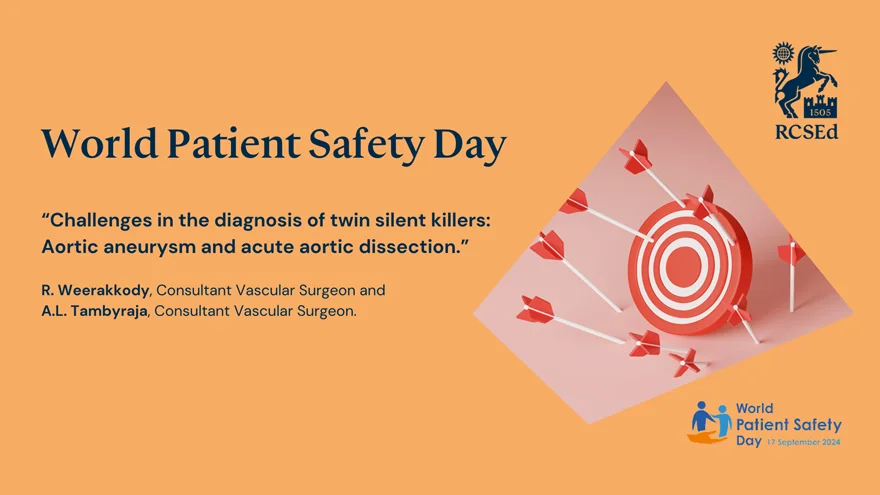
The Patient Safety Group (PSG) of the Royal College of Surgeons of Edinburgh (RCSEd) are delighted to lend our enthusiastic support to the sixth World Patient Safety Day (WPSD). This event, established by the World Health Organisation (WHO) in 2019, takes place on 17 September every year. It helps to raise global awareness amongst all stakeholders about key Patient Safety issues and foster collaboration between patients, health care workers, health care leaders and policy makers to improve patient safety. Each year a new theme is selected to highlight a priority patient safety area for action.
The theme set by the WHO for this year’s WPSD is “Improving diagnosis for patient safety”, recognising the vital importance of correct and timely diagnosis in ensuring patient safety and improving health outcomes.
A correct and timely diagnosis is key to the patient accessing the care they need; delayed, incorrect or missed diagnoses often lead to harm.
Diagnostic safety can be improved by addressing systems-based issues (such as communication failures, heavy workloads, ineffective teamwork) and cognitive factors (such as clinical training, experience, predisposition to biases, fatigue and stress) that can lead to diagnostic errors.
Background
In health, the aorta is a robust biomechanical structure responsible for piping blood from the heart to the rest of the body. In two, largely unpredictable, conditions - Aortic Aneurysm and Acute Aortic Dissection - an inherent weakness in the aortic wall, predisposes to fatal rupture or other major life-threatening complications.
Aortic Aneurysm usually remains asymptomatic and silent; often only presenting with sudden catastrophic rupture. There is gradual ballooning of part of the aorta, and at a critical size, rupture. A ruptured aneurysm is associated with up to 80% overall mortality and major morbidity in survivors of emergency surgical repair and it remains a leading cause of death in men >55 years.
Acute Aortic Dissection and other “Acute Aortic Syndromes” are rare (incidence 1 in 10,000 annually), but can be even more devastating and difficult to diagnose. They affect younger patients of both sexes equally. Here, there is sudden disruption of the structure of the aortic wall, whereby its overall integrity is compromised. This may result in aortic rupture and other major life-threatening complications and carries a 50% mortality. Acute aortic syndrome incidence is increasing and remains underdiagnosed.
When these conditions are identified early, the outcomes of aortic disease treated electively (prior to rupture or major complication) have steadily improved and currently, elective aortic aneurysm repair carries a relatively low risk of aneurysm related death. The rewards of early diagnosis and detection are high.
Diagnostic Challenge – Clinically
The major diagnostic challenge presented by aortic disease, is that it remains asymptomatic and undetected until one of the catastrophes above occur. Even when presenting with a rupture or dissection, symptoms can be vague or relatively benign in appearance, leading to misdiagnoses, before the diagnosis reveals itself – often too late - with a devastating consequences.
In spite of increased educational efforts and the greater availability of CT imaging than ever before (the current definitive diagnostic test), recent studies have shown that up to 30% of aortic dissections are still missed or diagnosed too late. An ongoing UK study into the misdiagnosis of acute aortic syndromes has identified the main reason for misdiagnosis as “atypical symptoms, false reassurances due to normal clinical findings, a reliance on investigations as ‘rule out’ tests, and a confirmatory bias towards investigations suggesting alternative diagnoses”.
Diagnostic Challenge – Imaging
CT scan is the favoured and gold standard diagnostic modality for the patient in the emergency department, but it is not a practicable use of resources to CT scan every patient with atypical chest, back or abdominal pain.
In the outpatient setting, aortic diameter is the main means of monitoring disease progression, but this is an imprecise predictor of risk of rupture. Therefore, a biomarker for aortic disease to aid diagnosis and risk stratification in aortic disease is regarded as an international research priority.
The Need for Biomarkers to Aid Clinical Diagnosis
The ideal aortic biomarker is a sensitive and specific blood test that will clearly identify an acute aortic event, and signal a ‘high risk’ aorta to the clinician.
Over the years, our group and others have investigated several serum biomarkers, some of which appear to correlate with acute aortic syndrome, but none have translated to be clinically relevant or reliable at detecting an unstable aorta. Our work is ongoing, investigating new candidate serum biomarkers and harnessing novel genomic technologies to identify potential genetic biomarkers of aortic disease activity.
Understanding the underlying biological mechanisms of aortic disease is also vital to identify underlying molecular pathways and therefore diagnostic and therapeutic targets. We have therefore created the Edinburgh Vascular biobank, which we hope to make a Pan-Scotland initiative as part of the Scottish Biorepository network, to biobank aortic tissue, blood and DNA from this rare but high priority patient group.
Written by R. Weerakkody, Consultant Vascular Surgeon and A.L. Tambyraja, Consultant Vascular Surgeon

